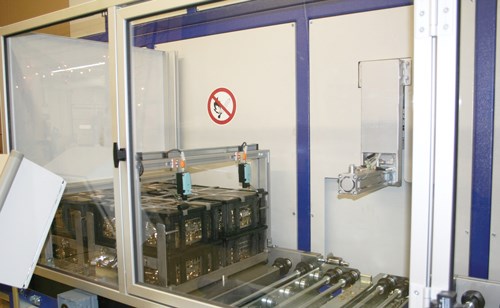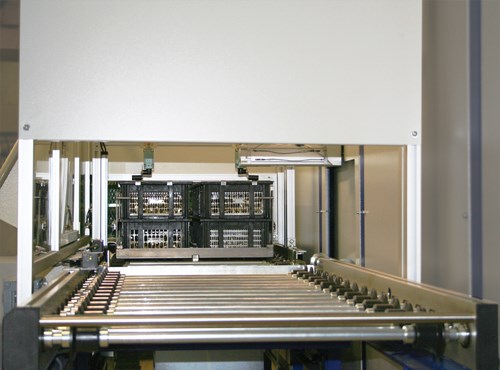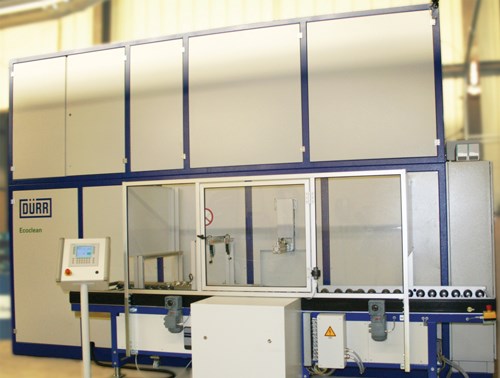From Nitric Acid Dip Cleaning To Closed-Loop Solvent Cleaning
Superior Products in Ohio has reduced annual water consumption from two million gallons to zero, dropped daily cleaning labor from 15 hours to one per day, and has achieved better cleaning results.
With the change from a nitric acid aqua based cleaning system to a closed-loop solvent system, Superior Products in Cleveland, Ohio, reduced annual water consumption from two million gallons to zero, dropped daily cleaning labor from 15 hours to one per day, and has achieved better cleaning results.
From its modest beginning in 1946 as a general screw machine company, Superior Products has grown its product lines to serve the welding, medical, beverage, cryogenic liquid and specialty gas industries worldwide with fittings, manifolds and assemblies.
Superior’s product range includes about 3,000 unique parts, which are developed and manufactured at their facility. The company machines 10 to 15 million pieces annually, primarily made of brass and stainless steel. After machining, the parts are contaminated with chips and swarf as well as cutting fluids and oils.
A Critical Step
As the parts are used in connection with compressed gas in industrial, medical, and specialty gas applications, they have to be cleaned to an oxygen clean standard.
The Compressed Gas Association allows no more than 47.5 mg/sq. ft. of organic material on the parts.
“If a dirty part is used in an oxygen system there is a chance of fire, because it is compressed gas that can lead to explosion. For quality and safety, it is critical that cleaning is done properly,” says Superior Products General Manager Iain Hodgekins.
The previous system used by Superior Products, a nitric acid bright dip cleaning system, reached a level of about 17 or 18 mg/sq. ft. Although it satisfied the cleanliness requirement, the cleaning system was about 30 years old, and many parts had to be re-cleaned. The system also used about two million gallons of water annually that had to be processed for heavy metals in the wastewater.
“It was a necessity to replace the cleaning system. We wanted a new system that would allow us to drastically reduce the impact on the environment. Additionally, we wanted a more reliable cleaning process that would require less re-cleaning and improve our efficiency and quality,” Hodgekins says.
Decision Based on Tests
For selecting the appropriate cleaning solution, Superior Products evaluated available cleaning procedures, from aqueous methods to solvent-based techniques, and talked to several cleaning machine manufacturers.
Based on cleaning tests conducted at Dürr Ecoclean’s facility in Wixom, Mich., Superior Products decided on the Universal 81C, a solvent-based, closed-loop cleaning system that uses non-chlorinated hydrocarbons.
“With this closed-loop system we have achieved excellent cleaning results; we don’t need water for cleaning, and we have no wastewater management issues. Dürr Ecoclean, Inc. also came highly recommended,” Hodgekins says. “We are part of the Precision Machined Parts Association and some association members recommended the Dürr machine over others, due in part to Dürr’s having local U.S. support and good service when service was needed.”
The Universal 81C is a single-chamber cleaning system that operates completely under vacuum. This eliminates the need for additional explosion protection when using combustible solvents such as isoparaffinic hydrocarbons. Additionally, the machine offers multiple monitoring of safety-relevant temperatures and pressures.
The Superior Products system is equipped with three flooding tanks for coarse and fine cleaning, as well as for application of a conservation fluid specifically for the brass parts. This ensures that parts don’t tarnish over time.
Improved Quality
The cleaning machine is configured for a multi-stage process composed of cleaning, rinsing, steam degreasing and drying. Using the standard high-performance injection flood washing (IFW), and an optional ultrasonic system, the unit can perform complex cleaning tasks with high process reliability.
A user-friendly design feature is the machine's ability to store eight freely programmable and selectable cleaning programs in its controller. The parameters include rotating and swiveling movements in the cleaning and drying chamber, temperature settings, ultrasonic characteristics, and IFW settings. In this way, the cleaning treatment can be customized to every part batch.
“We are currently using three programs, and we are very satisfied with the cleaning results. There are no parts that need to be re-cleaned, and the cleaned parts surfaces show a rest-level of organic materials of only 5 to 6 mg/sq. ft.” Hodgekins says. “Compared with our old system’s results, contamination has dropped by two thirds. This gives us very good peace of mind knowing that the machine is cleaning well above the standard.”
The vacuum drying technique ensures that even parts with a complex geometry, such as bores, blind holes and undercuts, emerge from the process fully dried.
The fully automatic vacuum distillation unit as well as full-flow and bypass filtration, which come standard, remove oil, grease, chips and swarf from the solvent on a continuous basis. So the cleaning fluid lasts a long time without needed to be changed.
Fully Automatic
Depending on part geometry and sensitivity, parts are cleaned either in bulk-baskets or arranged in pin-racks used at Superior Products to carry the parts throughout the shop.
Four of the baskets or pin-racks can be loaded into a carrier system specially designed by Dürr Ecoclean. The batches get transported into the machine’s cleaning chamber by an automatic conveyor feeding system that identifies the products by a proximity sensor and automatically chooses the appropriate cleaning program.
“After looking at the additional cost for the proximity sensor, I don’t know why it is not included with every automatic conveyor system.” Hodgekins says. “We can not only put anybody in the company on the cleaning machine and they will do a good job, the proximity sensor also saves a lot of manual labor.”
Depending on the program, the cleaning cycle takes between 81/2 and 9 minutes to complete. When the batch comes out of the machine, it travels down a track to be put into inventory.
Hodgekins says the old system required two operators for eight hours a day to clean parts. Due to the fully automatic cleaning process with the Universal 81C, the manual labor for cleaning has dropped to one hour per day.
“We save the equivalent of 15 hours’ work each day. Additionally, the new cleaning process saves us two million gallons of water annually and the associated wastewater treatment,” Hodgekins says. “Taking these savings into account, the return on investment on the machine is conservatively about two years.”
Although the reduced impact on the environment cannot be rated in dollars, Superior Products reached its environmental goals, and that gives the Hodgekins a good peace of mind, too.
For information on Dürr Ecoclean, please call 1-248 560-2100, or visit Durr-ecoclean.com
Related Content
Testing Safe Alternative Conversion Coatings
A joint test protocol was developed by a hex chrome-free consortium to best evaluate the most recent commercially available alternative conversion coatings. This article reveals the findings.
Read MoreVacuum Degreaser Cleans Up a Messy Situation
By replacing its immersion parts washer with a vacuum degreasing system, this machine shop is much more efficient, saving the company money, man hours and the health of the operators.
Read MoreTop Reasons to Switch to a Better Cleaning Fluid
Venesia Hurtubise from MicroCare says switching to the new modern cleaning fluids will have a positive impact on your cleaning process.
Read MoreRead Next
Basket Case for Parts Maker Proves Sane Idea
Dürr Ecoclean’s Universal 81W chamber parts washer is for basket cleaning.
Read MoreEducation Bringing Cleaning to Machining
Debuting new speakers and cleaning technology content during this half-day workshop co-located with IMTS 2024.
Read MoreA ‘Clean’ Agenda Offers Unique Presentations in Chicago
The 2024 Parts Cleaning Conference, co-located with the International Manufacturing Technology Show, includes presentations by several speakers who are new to the conference and topics that have not been covered in past editions of this event.
Read More

























